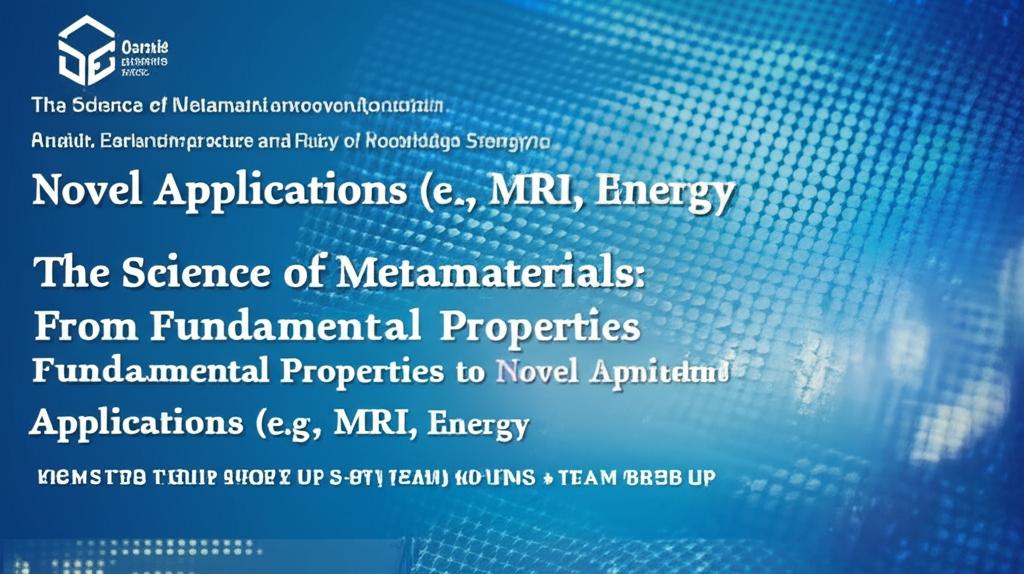Metamaterials, with their engineered structures that exhibit properties not found in nature, are at the forefront of materials science innovation. These materials are designed and fabricated by manipulating the architecture of fundamental materials like metals, polymers, ceramics, and even biomaterials, often at the nanoscale. This precise structural control allows scientists to achieve extraordinary characteristics such as a negative refractive index, the ability to manipulate electromagnetic waves (including light), and tailored electrical and magnetic responses.
Fundamental Properties Driving Innovation:The unique behaviors of metamaterials stem from their carefully designed subwavelength structural elements. These structures can interact with electromagnetic, acoustic, or even seismic waves in ways that conventional materials cannot. Key properties include:
- Negative Refractive Index: This allows metamaterials to bend light in unconventional ways, opening doors for applications like superlenses and cloaking devices.
- Electromagnetic Wave Manipulation: Metamaterials can control the amplitude, phase, and polarization of electromagnetic waves. This has led to breakthroughs in antenna technology, enabling more efficient and compact designs, particularly for 5G and future wireless communication networks.
- Tailored Permittivity and Permeability: Scientists can fine-tune the electric and magnetic responses of metamaterials, leading to customized interactions with electromagnetic fields.
- Acoustic and Seismic Wave Control: Beyond electromagnetism, metamaterials are being developed to manipulate sound waves for applications like noise cancellation and to mitigate the impact of seismic waves in earthquake-prone regions.
The ability to engineer these fundamental properties has paved the way for a diverse range of cutting-edge applications:
1. Magnetic Resonance Imaging (MRI) Enhancement:Metamaterials are revolutionizing MRI technology. Conventional MRI improvements often rely on stronger static magnetic fields, which come with safety concerns and higher costs. Metamaterials offer an alternative by:
- Improving Signal-to-Noise Ratio (SNR): By enhancing the SNR, metamaterials lead to higher-resolution images, allowing for more accurate diagnoses.
- Reducing Scan Times: Enhanced signal quality can potentially shorten the duration of MRI scans.
- Increasing Patient Safety and Comfort: Some metamaterial designs can shield organs from unwanted electromagnetic radiation. Lightweight, flexible, and even wearable metamaterials, such as those made from coaxial cables or embedded in textiles, are being developed to conform to body parts, improving patient comfort and image quality. These materials can be designed to be wireless, eliminating the need for bulky cabling.
- Making MRI More Accessible: Researchers are focused on using low-cost materials to create metamaterial components, which could make MRI technology more affordable and globally accessible. Coaxial cable-based metamaterials, for instance, offer a cost-effective way to boost MRI signals.
Metamaterials present exciting possibilities for a more sustainable energy future:
- Ambient Energy Conversion: Their unique structures can efficiently convert various forms of ambient energy – such as electromagnetic waves, sound waves, or mechanical vibrations – into electrical energy. For example, PVDF-based metamaterials have shown the ability to convert mechanical energy (vibrations) into electricity.
- Enhanced Thermal Management: Thermal metamaterials can control heat flow in unprecedented ways. This has applications in:
Passive Daytime Radiative Cooling (PDRC): Metamaterials can be designed to radiate heat away from objects, even under direct sunlight, offering power-free cooling for buildings, vehicles, and electronics.
Thermal Energy Storage: Advanced thermal metamaterials can improve the efficiency of thermal batteries and heat exchangers.
* Waste Heat Harvesting: They can be used to capture and repurpose industrial waste heat.
- Mechanical Energy Storage: Recent breakthroughs have led to mechanical metamaterials capable of storing and releasing elastic energy at significantly higher levels than conventional materials. By twisting rods into helical shapes within a metamaterial structure, researchers have achieved greatly increased energy storage capacity, with potential applications in robotics, shock absorption, and energy-efficient machines.
The versatility of metamaterials extends to numerous other fields:
- Wireless Communications: Metamaterials are enhancing 5G and future wireless networks by improving antenna efficiency and bandwidth. Reconfigurable Intelligent Surfaces (RIS) made from metamaterials can reflect and refract signals for better indoor coverage, potentially reducing the need for numerous cell towers.
- Invisibility Cloaking: While still largely in the research phase, the ability of metamaterials to redirect light waves around an object holds the potential for creating cloaking devices.
- Earthquake Protection: By attenuating seismic waves and resisting their propagation, metamaterials incorporated into building materials (like steel and carbon fiber-reinforced polymers) could significantly improve structural safety in earthquake zones.
- Advanced Sensing: The high sensitivity of metamaterials to their environment makes them ideal for developing next-generation sensors.
- Acoustic Manipulation: Metamaterials are being used for noise cancellation, acoustic focusing, and even acoustic stealth.
- Optical Devices: Ultra-thin metasurfaces are being developed to manipulate light in novel ways, such as efficiently generating circularly polarized light, which is crucial for medical imaging, advanced communications, and quantum physics. This could lead to more compact and efficient optical devices.
The field of metamaterials is rapidly evolving, driven by advances in computational design, simulation tools (including AI-driven design), and fabrication techniques like 3D printing, lithography, and nanotechnology. Researchers are continually exploring new material compositions, structural designs, and manufacturing processes to unlock even more sophisticated functionalities. The focus is increasingly on developing tunable, reconfigurable, and "smart" metamaterials that can adapt to changing conditions or respond to external stimuli.
Challenges remain in terms of scalability, manufacturing precision, and integrating metamaterials into existing technologies. However, ongoing interdisciplinary collaboration between physicists, engineers, materials scientists, and chemists promises to overcome these hurdles, translating metamaterial innovations from the lab into real-world solutions that address global challenges in healthcare, energy, communications, and beyond. Upcoming conferences in 2025, such as META 2025 and Metamaterials'2025, will continue to showcase the latest breakthroughs and foster further advancements in this exciting field.

